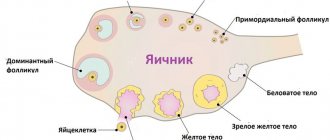Why do they make a BT schedule?
A simple home test that can be used to assess hormonal hemostasis and track the fertile phase of the cycle is to keep a basal temperature chart. Basal temperature (BT) is the lowest body temperature per day at rest. Measurement indicators immediately after waking up from a night's sleep are considered more relevant than others. That is why the temperature is measured while still lying in bed. There are several measurement methods:
- oral;
- vaginal;
- rectal.
The most effective is the rectal method.
The measurement results are entered into a table and a graph is constructed based on them. Based on it, you can clearly judge the onset of ovulation: approximately a day before it, the temperature drops, and on the day of ovulation it rises by an average of 0.5 degrees. Keeping a basal temperature chart is a kind of biological method of contraception that allows you to regulate the onset of pregnancy by calculating days that are safe for unprotected sexual intercourse and days on which conception is most likely.
What do gynecologists say?
Modern gynecology does not consider basal temperature to be an informative indicator of the stages of the menstrual cycle; indications are especially unreliable while taking medications, especially hormonal ones. This method is quite justified as a home way to control your cycle. But medicine offers another method of control - laboratory tests.
To monitor hormone levels, a blood test is performed, the direction for which is given by the attending physician. The test results make it possible to more reliably judge the patient’s condition and assess hormonal levels. That is why, if hormonal medications are prescribed, you can stop keeping a basal temperature chart without a twinge of conscience.
Even more meaningless is measuring whether a woman is prescribed hormone therapy or not. In early pregnancy, BT goes up, but up to certain limits: not higher than 37.5 degrees.
So, Duphaston or Utrozhestan are effective drugs containing progesterone, which are prescribed not only during pregnancy, but also in a number of cases of problems with the reproductive system in women. When taking medications, keeping a chart of basal temperature is a low-informative method of monitoring ovulation, so you should turn to more modern methods (tests, laboratory diagnostics), which can be recommended by your attending physician.
Conceiving a fetus can sometimes be complicated by unfavorable factors - such as stress, health problems in a man or woman. The onset of a planned pregnancy may be delayed due to a lack of the hormone progesterone. It is not advisable to despair in such cases, since there is a medicine that replaces natural progesterone. This is Duphaston.
What is this drug? As already noted, Duphaston replaces progesterone. It helps a patient who has problems with the production of such an active substance to conceive an embryo and carry it to term. The drug is prescribed to women with menstrual cycle disorders, endometrial dysfunction and other similar problems. This drug should be used on strictly defined days and according to the schedule prescribed by the gynecologist.
Duphaston is well tolerated by women. It can also be consumed during the period of gestation, as it does not harm the fetus. It is not prescribed to a nursing mother because it can pass into milk.
The following side effects from taking the medicine are observed:
- enlargement of the mammary glands;
- swelling of the limbs;
- anemia;
- allergies (this occurs as a result of drug intolerance).
You should not take this medicine if you have a hormone-dependent tumor. It is necessary to monitor menstruation in order to adjust the dosage if necessary.
Regimen for taking Duphaston and Utrozhestan
Therapy with hormone-containing drugs is an effective method of regulating the cycle, treating infertility and some diseases characterized by a lack of endogenous hormones. Thus, many problems of the female reproductive system are caused by a lack of progesterone, a hormone that affects not only the monthly cycle, the onset of pregnancy and its progression, but also the production of other steroid hormones.
Duphaston is a drug based on dydrogesterone, a synthetic progesterone analogue. The release form of Duphaston is oral tablets. The drug has a progestogenic effect on the uterine mucosa without disrupting the cycle, promotes conception and eliminates the threat of miscarriage. Duphaston is prescribed for a number of problems, such as:
- infertility caused by luteal phase deficiency;
- threat of miscarriage during pregnancy;
- premenstrual syndrome;
- absence of menstruation due to irregular cycles;
- uterine bleeding;
- endometriosis.
Depending on the disease, Duphaston is prescribed according to a specific dosage regimen on different days of the cycle:
- for infertility - from the 14th day of the cycle to the 25th, 10 mg per day for a course of six months;
- if there is a threat of miscarriage - 40 mg once and then 10 mg daily every 8 hours until the symptoms disappear;
- during the period of bleeding to stop it - 5-7 days, 10 mg twice a day;
- to prevent bleeding - from the 11th day of the cycle to the 25th, 10 mg twice a day;
- for endometriosis - from days 5 to 25 of the cycle, 10 mg in two doses per day.
Duphaston has established itself as an effective hormonal drug with minimal side effects.
There is another analogue of progesterone in capsules - this is Utrozhestan. The effectiveness of Utrozhestan is due to the properties of the progesterone it contains, which is identical to natural biological progesterone, which is produced by the corpus luteum of the ovaries after ovulation, as well as during pregnancy with the placenta. Progesterone is extracted from yam (a tuber plant), so the drug is not synthetic.
Utrozhestan or Duphaston - which is better?
Utrozhestan is prescribed for the same indications as for women on Duphaston: both during pregnancy and for problems with the female genital area. The main difference from the synthetic analogue is in the method of application. If Duphaston is a drug for oral administration, then Utrozhestan is taken both orally and intravaginally. The latter option reduces the risk of side effects, since, acting locally, it eliminates the manifestations of vomiting and nausea.
Utrazhestan and Duphaston are interchangeable, and the difference in price is also insignificant. But why then is one drug or another prescribed to different patients? The point here is less about the diagnosis and more about the doctor. There are doctors who are more “trusting” of one drug, while others are more “trusting” of another, and this is reflected in the practice of prescribing. So if the pharmacy suddenly runs out of Duphaston, you can safely purchase Utrozhestan, and vice versa - this will not affect the patient’s condition in any way. But doctors are not particularly fond of such willfulness, so it is better to discuss the issue of interchanging these progesteronogens in advance, so that there is no confusion in the dosage and course of taking the drugs.
It is worth realizing that these drugs are not contraceptives, and treatment in recommended dosages does not provide protection against conception! Due to the possible likelihood of metabolic disorders and thromboembolic complications, it is necessary to discontinue medications if:
- ophthalmological disorders: loss of vision, double vision, vascular lesions of the retina, disorders of the optic nerve;
- venous complications: thrombotic or thromboembolic;
- migraines and headaches.
The drugs are ineffective in cases of threatened miscarriage, since approximately 50% of spontaneous abortions in the first trimester are caused by genetic complications or infections. Therefore, hormonal support in such cases is justified only if there is insufficient production of one’s own progesterone.
☆
Sooner or later, every couple begins to think about starting a family, having and raising children. But not everyone’s desire coincides with their health capabilities. What only a couple of months ago seemed like an approaching reality has become a painful and difficult task to achieve. As you guessed, we are talking about pregnancy. Young couples are not always aware of the “pitfalls” that become an obstacle to the desired fertilization. And oddly enough, the main burden of the reasons lies on the fragile shoulders of the woman, because she first needs to become pregnant, and then create ideal conditions for bearing the fetus.
One of the likely reasons for failures in pregnancy may be a weak luteal phase, in other words, progesterone deficiency.
Most often, the therapeutic “pill” in this case is the drug Duphaston. Since we are talking about conception, a woman must know the relationship between Duphaston and basal temperature (BT).
Side effects of duphaston
Duphaston does not cause temperature changes even in the form of side effects. The normalization of the menstrual cycle and the health of the pregnant child should also not be a cause for concern if duphaston is abandoned.
You can discuss the influence of Duphaston on the forum
Conceiving a child does not always follow a standard and simple pattern. It is quite possible that there are interfering circumstances, for example, stressful situations. In addition, the problem may lie in the health of the man or woman. A special burden lies precisely on the shoulders of expectant mothers, since they need not only to get pregnant, but also to bear the child. One of the possible reasons for the lack of a long-awaited pregnancy may be luteal insufficiency or lack of progesterone. In this case, do not despair, since there is a medicinal alternative to solving the problem. In this case, the drug duphaston can act as an analogue of natural progesterone. Given certain characteristics in terms of conception, women should know whether there is a connection between the use of duphaston.
What kind of “beast” is this basal temperature?
Basal temperature is the lowest body temperature per day, which is established in the human body during the rest period, i.e. during sleep. To obtain its true values, measurements are carried out rectally immediately after waking up, without getting out of bed.
Daily morning BBT measurements will help a woman not only find out the favorable moment for conception (ovulation), but also determine the onset of pregnancy, identify hormonal imbalances in time, or detect some diseases of the endocrine system.
In a healthy woman, BT has an oscillating nature, which depends on the period of the menstrual cycle. In the first phase of the cycle (follicular), the temperature is constant within the range of 36.3–36.8º C.
With the arrival of ovulation, the basal temperature begins to rise sharply to 37? C and above, and maintains such values throughout the luteal phase, until menstruation. Further, if pregnancy does not occur, BT decreases again.
Pharmacological action of Duphaston
Duphaston (dydrogesterone) is a synthetic progestogen that has a direct effect on the uterine mucosa. Indicated for use by women who have a hormonal imbalance in order to normalize the menstrual cycle, successful pregnancy and provide a reliable “platform” for bearing a fetus.
The main purpose of using Duphaston is replenishment in a woman’s body
the missing hormone - progesterone, since this drug is its absolute analogue. In addition to the reproductive problem, which, to some extent, he is able to solve, there are other women’s health problems that he corrects: endometriosis, dysmenorrhea, PMS, dysfunctional uterine bleeding, threats of abortion.
The drug is taken on strictly defined days, since the production of specific hormones occurs at different periods of the cycle.
For progesterone deficiency, Duphaston is prescribed from the middle of the monthly cycle, namely from the 14th to 25th day, for six months. If conception is successful, it is advisable to continue taking it for some time to avoid disruption of the long-awaited pregnancy.
What is duphaston?
Duphaston is a drug in demand on the pharmacological market that replaces natural progesterone. This remedy helps a woman with problems with the production of natural hormones to conceive and safely bear a child.
The active component of this drug is dydrogesterone, which helps the pituitary gland produce lutein, which is required for successful conception.
The drug is prescribed to women with other pathologies: menstrual irregularities (amenorrhea or heavy bleeding during menstruation). Duphaston is prescribed for treatment of endometrial disorders.
Its intake is necessary on strictly defined days, corresponding to the days of production of a certain hormone.
Patients taking this drug tolerate it well; any isolated bleeding associated with taking duphaston is eliminated by increasing the dose of the drug.
Duphaston is also prescribed during pregnancy; this drug does not harm the development of the embryo. However, during lactation it is not prescribed to a nursing mother, since hormones are easily transferred to the baby with milk.
Side effects from taking duphaston are:
- Breast engorgement,
- Swelling of the limbs,
- Anemia,
- Allergic manifestations caused by intolerance to dydrogesterone.
The drug is not prescribed to women with hormone-dependent tumors, as well as to those who are susceptible to galactose with reduced lactose.
While taking duphaston, it is necessary to monitor the nature of menstruation in order to control the dose and advisability of taking the drug.
Is there a connection between Duphaston and basal temperature?
Maybe this question will seem strange and unimportant to some, but women whose attempts to conceive have failed will understand its importance. However, there were some surprises here too.
It turns out that opinions on the effect of Duphaston on basal temperature are controversial.
Clinical studies of this drug claim that Duphaston has no effect on changes in BT, although it is a synthetic analogue of natural progesterone. Its action is just an auxiliary “contribution” to the process of attachment of a fertilized egg to the prepared endometrial layer and to increasing the chances of successful pregnancy. Therefore, based on the studies conducted, there is no point in discontinuing the drug.
Contrary to the clinical results, there are real-life experiences of many women. Most people taking this drug noticed a change in the “behavior” of the BT schedule - for some, the temperature increased where it should have decreased, for others - on the contrary. This phenomenon can be explained as follows:
- Individuality of the organism. If one hundred tested women did not feel the effect of Duphaston on BT, then there is no guarantee that the one hundred and first will not also feel these changes. Perhaps her individual structure of the hormonal system and the whole organism as a whole will contribute to the development of a particular case of a reaction to the drug.
- Error in drug prescription. As unpleasant as it may sound, doctors make mistakes. Some due to inexperience, others due to negligence or ignorance. But there is also such a type of specialist as “self-proclaimed doctors” - these are women who diagnose themselves and prescribe treatment, which is absolutely forbidden to do. Whatever the reason, the result is a change in BT while taking Duphaston.
I would like to note that the prescription of this drug should not be based only on BT values. The main indication is hormone tests.
If luteal phase deficiency is confirmed, then we can talk about introducing a progesterone analogue into the body. If it is prescribed without a preliminary examination, then the result can be either an excess or a deficiency of the hormone necessary for the second phase of the menstrual cycle. Both cases will prevent a normal pregnancy.
It has definitely been proven that an excessive dose of the drug (more than 30 mg per day) can affect ovulation and basal temperature.
No matter how much you would like it, there are difficulties and difficulties in life that need to be overcome. Some failures in fertilization and pregnancy are surmountable. It is only necessary to adequately and carefully treat the problem, and not follow the path of self-medication or “blind” medical diagnosis. Be smart and hope for the best!
https://yagotova.ru
Basal temperature when taking Utrozhestan
Women planning a pregnancy are interested in how Utrozhestan affects basal temperature. This is a hormonal medicine, similar in composition to progesterone. The active substance normalizes the condition of the endometrium of the uterus. It significantly increases the likelihood of getting pregnant and prevents termination of pregnancy at the risk of spontaneous abortion.
When taking such a medicine, it is possible to achieve an effect in a short time, since the basal temperature when taking Utrozhestan increases.
Why should you take Utrozhestan? This medicine should be taken to solve the following problems:
- proliferation of cells in the endometrium (since Utrozhestan increases the basal temperature, its condition is normalized and the development of pathological processes in the female intimate organs is excluded);
- Utrozhestan with a decrease in basal temperature is indicated in cases where infertility associated with ovarian dysfunction should be treated;
- threatened abortion;
- recurrent miscarriage;
- bleeding from the uterus due to disruption of hormone secretion;
- since Utrozhestan’s effect on basal temperature is positive, that is, it increases it, this drug can be used to plan pregnancy, provided that the woman’s progesterone is low.
Progesterone is very important in the female body. It is produced in the corpus luteum.
How does Utrozhestan interact with basal temperature during pregnancy? If a woman takes this medicine correctly, then the hormonal levels are then normalized, and the risk of miscarriage can be reduced. When there has been no fertilization, the corpus luteum is destroyed and progesterone is not produced. But if conception has occurred, then progesterone continues to be produced (first by the corpus luteum, and then, after the twelfth week of pregnancy, by the placenta). Progesterone is necessary for the growth of the endometrium, stopping the growth of a new follicle if fertilization has occurred, for the growth of the mammary glands, and reducing the contractile activity of the uterus.
How does the drug affect the fetus? Women who do not know whether Utrozhestan affects basal temperature believe that it can cause harm to the fetus during pregnancy. It is not right. Long-term clinical studies show that with the correct dosage of this medicine during pregnancy, it benefits the fetus. After all, low temperature negatively affects it. Taking the medicine allows you to smooth out the fluctuations in BT, and the baby in the mother’s womb will develop normally. In any case, it is advisable to visit a specialist before taking the drug. He will give information about whether it is advisable to take the drug, prescribe the correct dosages and recommend a schedule for taking the drug. He will also guide the patient regarding any contraindications to taking the drug.
The positive properties of Utrozhestan are:
- favorable conditions are created for the development of the embryo, and thanks to this the pregnancy develops normally;
- the likelihood of developing acute placental insufficiency decreases;
- conditions are created for the normal supply of blood and oxygen to the embryo;
- under the influence of Utrozhestan, the placenta matures normally;
- ensures the full development of the embryo;
- with a high degree of probability the child will be born full-fledged, healthy, with normal weight and muscle tone;
- the likelihood of dangerous damage to the nervous system in the fetus is reduced.
Usually the medicine is well tolerated by patients. As an undesirable effect, uterine bleeding may develop. It can be eliminated if you increase the dosage recommended by your doctor. Sometimes a slight discharge of blood in the first two days from the start of treatment may be normal and is not a cause for concern.
If the bleeding continues, then you need to consult a doctor to adjust the therapy. We draw the attention of women that self-medication with this medicine is strictly prohibited, because this can lead to serious complications.
Please note that the drug has no analogues. If there is intolerance to such a medicine (which is extremely rare), or if allergic reactions occur, the gynecologist prescribes the drug to the patient in a slightly lower dose.
In rare cases, this medicine may cause drowsiness. Sometimes, with severe toxicosis, the doctor recommends that the patient take Utrozhestan in the form of vaginal suppositories.
izmerenie-bazalnoy-temperatury.ru
Errors in measurements
The indicators may also be affected by measurement errors or external factors:
- Stress, nervous tension;
- Physical exercise;
- Drinking alcohol;
- Cold;
- Flights;
- Changes in climatic conditions;
- Sexual intercourse shortly before measurement;
- Insomnia, inadequate sleep.
Studies show that basal temperature does not change in any way after taking Duphaston. If after a course of treatment pregnancy does not occur, then with the start of a new cycle you will again record the same 36.2-36.5 ° C in the first half of the cycle. Then there will be a decrease on the eve of ovulation by 0.2°C, and during and after ovulation in the second phase of 37.0-37.5°C, and the next decrease will appear a couple of days before the next menstruation, if conception does not occur.
Secrets of the drug Duphaston
Duphaston tablets are a synthetic hormone progesterone (gestagen) of the latest generation.
This drug is the pride of scientists who have been working for 30 years to create synthetic analogues of biologically active substances important for humans. Hormonal drugs are usually made on the basis of the male hormone testosterone, which has an androgenic effect:
- Rough voice;
- Excess body hair;
- Similar.
Duphaston does not have such “surprises”, because it is made from dydrogesterone, which is as close as possible to the natural hormone progesterone. For drug manufacturers, this is their pride. This is one of the first positive aspects of Duphaston.
Among other things, the drug does not have such side effects as:
- Estrogenic action;
- Anabolic effect;
- Glucocorticoid effect;
- And thermogenic activity.
Duphaston is widely used to treat many women's problems. The list is quite impressive:
- Lack of luteal phase of the cycle (lack of progesterone);
- Endometriosis diseases;
- Infertility caused by progesterone deficiency;
- Risk of miscarriage;
- Habitual miscarriages;
- Explicit PMS;
- Painful menstrual bleeding;
- Malfunctions in the monthly cycle;
- Repeated amenorrhea (prescribed in complex treatment with an estrogen substitute);
- Uterine bleeding;
- Hormone replacement therapy.
Like any other drug, Duphaston has some contraindications. But there are so few of them that this makes many patients happy.
Tablet regimen and dosage
Duphaston are small white capsules.
Each tablet contains 10 mg. dydrogesterone. To ensure that the compound is stable, the drug contains additional substances so that the synthetic hormone does not disintegrate in its natural environment. Schemes and doses of the drug are prescribed only by a doctor, depending on the disease. Each specific disease has its own treatment regimen and dosage. Therefore, first you need to establish an accurate diagnosis, and then the doctor will prescribe a suitable course of treatment. In addition, treatment must be carried out under the strict supervision of a specialist.
In all cases, the daily dose of the drug is divided into several doses and taken at the same time. Take Duphaston with a small amount of water. A prerequisite is to take the pills strictly at certain phases of the cycle.
An approximate method of administration for women planning pregnancy is as follows:
- For progesterone-related infertility, drink 20 mg per day. Divide into two doses. The course of treatment begins on the day of ovulation (day 14 of the cycle) and ends on the 25th day of the menstrual cycle. Typically, three to six courses of treatment with Duphaston are carried out. If during this time a woman becomes pregnant, the drug is not discontinued; it must be taken for some time.
- If pregnancy does not occur due to uterine endometriosis, the drug is prescribed from the 5th day of the cycle to the 25th day. The usual dose is 2 tablets per day. Depending on the stage of the disease, the doctor may increase the dose of the drug.
There is an opinion that abrupt withdrawal of Duphaston during conception can cause pregnancy failure, but this is an unproven fact. All questions that arise should be discussed with your doctor.
Duphaston may cause some side effects:
- Migraine, dizziness;
- Impaired liver function;
- General weakness, malaise;
- May increase breast sensitivity;
- From the gynecological side - breakthrough bleeding;
- Bloating and abdominal pain;
- Rarely - hemolytic anemia;
- Sometimes, peripheral edema;
- Allergies: rash, urticaria, Quincke's edema.
If the patient experiences any sign of a side effect, the attending physician should be informed about this. He will adjust the dose or prescribe another suitable drug.
Start taking after ovulation
If it is necessary to maintain optimal hormonal levels and delicately regulate them, Duphaston is prescribed from the moment of ovulation, after the release of a mature egg. This phase is always accompanied by a natural increase in progesterone levels.
Duphaston for conception is taken 1 tablet 2 times a day
The “pregnancy hormone” (or its medicinal analogue) supports the development of the corpus luteum after fertilization, helps the endometrium prepare for embryo implantation, and helps normalize the tone of the uterus.
Duphaston is also prescribed when there is a threat of pregnancy failure due to detachment of the ovum, uterine hypertonicity, hematomas or bleeding.
What day after ovulation should you start taking Duphaston?
Duphaston comes to the rescue if examination has demonstrated that the body does not produce enough progesterone. Hormonal support is required for a mature egg immediately after ovulation . Ultrasound monitoring allows you to accurately calculate this period.
BT schedule while taking Duphaston - pregnant
The medicine is taken until the 25th day of the cycle, 2 times a day, one tablet. If a woman took Duphaston after ovulation and became pregnant, the doctor may not cancel the prescription and will only review the dosage of the drug. The medicine prevents spontaneous miscarriage.
On what day does ovulation occur on Duphaston?
Duphaston is actively used to combat mild forms of endometriosis (one of the most common causes of infertility). Hormone-dependent benign pathology develops against the background of excessive production of estrogen in the body. Duphaston suppresses this process, causes regression of disease foci and helps restore reproductive function.
For this purpose, the drug is prescribed from the 5th to the 25th day of the menstrual cycle, 1 tablet 2 times a day (standard dosage). The duration of the course depends on the effectiveness of therapy. Treatment can continue for 6 months.
If you need to know on what day ovulation occurs on Duphaston, then, subject to standard use from the 5th day, the egg is released from the follicle on approximately 9-11 days of use. However, ovulation may not happen for a number of reasons. It is recommended to use ovulation tests several cycles in a row to determine the individual effect of the drug on your body.
As medical practice shows, taking medication in a correctly calculated dosage, with some exceptions, does not affect the timing of ovulation. It occurs approximately in the middle of the menstrual cycle (day 13-15 in a 28-day cycle). Deviations are a consequence of other processes in the body or its individual characteristics.
Application of Actovegin
Discussion: 4 comments
- Marina:
04/14/2014 at 14:13I have never used such a method of monitoring ovulation as basal temperature. And the doctor, when prescribing Duphaston for the treatment of endometriosis, did not mention that it could somehow influence this. Yes, for me it was not particularly important.
- Anna:
04/30/2014 at 15:53
Duphaston helped my friend get pregnant, not immediately of course, after 3-4 months of taking it. Her Progesterone was completely zero, so this drug helped. And by the way, her cycle lasted up to 40 days.
- Natasha:
05.11.2016 at 12:47
I've been taking duphaston for the 5th day in the morning, my temperature rose to 37.7, maybe it's because of it, I've never had a cold before
- Elena:
05/04/2017 at 16:56
Different sources write different information about the drug, and based on “scientific” studies, here they write that it does not affect the temperature, but on another site they show statistical data with temperature measurements in the 2nd phase, and it is increased. During my initial intake, my temperature appeared towards the end of taking duphaston. and for the second cycle of admission, for the next one. day after starting the drug, stable 36.8-37.1. The doctor says that in phase 2 this is the norm, but never in my life have I noticed an elevated temperature in phase 2, except for the period of colds.











